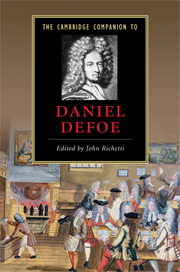Book contents
- Frontmatter
- Introduction
- 1 Defoe: the man in the works
- 2 Defoe’s political and religious journalism
- 3 Defoe, commerce, and empire
- 4 Defoe and criminal fiction
- 5 Money and character in Defoe’s fiction
- 6 Defoe’s Tour and the identity of Britain
- 7 Defoe as narrative innovator
- 8 Gender and fiction in Moll Flanders and Roxana
- 9 Defoe and London
- 10 Robinson Crusoe: varieties of fictional experience
- 11 Defoe: satirist and moralist
- 12 Defoe and poetic tradition
- Further Reading
- Index
6 - Defoe’s Tour and the identity of Britain
Published online by Cambridge University Press: 28 March 2009
- Frontmatter
- Introduction
- 1 Defoe: the man in the works
- 2 Defoe’s political and religious journalism
- 3 Defoe, commerce, and empire
- 4 Defoe and criminal fiction
- 5 Money and character in Defoe’s fiction
- 6 Defoe’s Tour and the identity of Britain
- 7 Defoe as narrative innovator
- 8 Gender and fiction in Moll Flanders and Roxana
- 9 Defoe and London
- 10 Robinson Crusoe: varieties of fictional experience
- 11 Defoe: satirist and moralist
- 12 Defoe and poetic tradition
- Further Reading
- Index
Summary
At the start of the second volume of his Tour thro' the Whole Island of Great Britain (1724-26), Defoe reflects on the progress of his circuit to date. His supposed journey had got as far as Land's End, the extreme tip of the British landmass as it juts out into the Atlantic Ocean. “My last letter ended the Account of my Travels, where Nature ended her Account, when she meeted out the Island, and where she fix'd the utmost Western Bounds of Britain.” (Tour II, 9) / The syntax equates Defoe's own narrative with the “Account” of nature herself, and prepares us for a ceremonial beating of the national bounds conducted by the author as he carries forward his description of the country's imagined corners. This sentence continues: “... being resolv'd to see the very Extremity of it, I set my Foot into the Sea, as it were, beyond the farthest Inch of dry Land West, as I had done before near the Town of Dover, at the Foot of the Rocks of the South-Foreland in Kent, which, I think, is the farthest Point East in a Line; And as I had done, also, at Leostoff in Suffolk, which is another Promontory on the Eastern Coast, and is reckon'd the farthest Land Eastward of the Island in general; Likewise I had used the same Ceremony at Selsy near Chichester, which I take to be the farthest Land South ... so, in its Place, I shall give you an Account of the same Curiosity at John a Grot's House in Caithness, the farthest Piece of Ground in Great Britain, North.” (Tour II, 9)
- Type
- Chapter
- Information
- The Cambridge Companion to Daniel Defoe , pp. 102 - 120Publisher: Cambridge University PressPrint publication year: 2009

